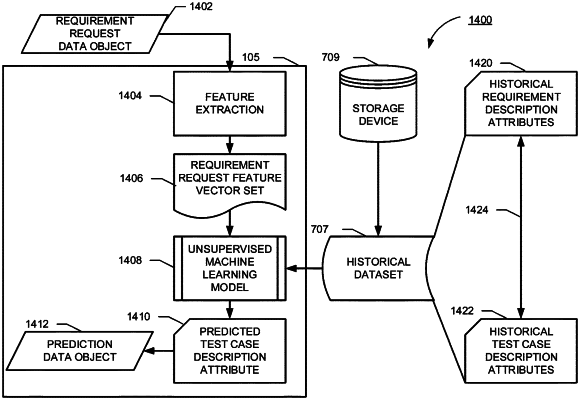| CPC G06F 11/3688 (2013.01) [G06F 11/3684 (2013.01); G06F 11/3692 (2013.01); G06N 20/00 (2019.01)] | 19 Claims |

|
1. An apparatus comprising one or more processors and at least one non-transitory memory comprising computer program code, the at least one non-transitory memory and the computer program code configured to, with the one or more processors, cause the apparatus to:
receive, originating from a client device, a requirement request data object, wherein the requirement request data object comprises at least: (i) a requirement request description attribute for a software testing task and (ii) a test case number threshold attribute indicating a test case number threshold for testing an objective associated with the requirement request description attribute;
generate, based at least in part on the requirement request description attribute and using a supervised machine learning model, at least one of (i) a predicted complexity attribute or iii) a predicted work track attribute corresponding to the requirement request data object;
determine, based at least in part on the requirement request description attribute, a requirement request feature vector set;
determine, using an unsupervised machine learning model, a plurality of similarity scores associated with the requirement request feature vector set and a historical dataset,
determine a similarity ranking for a plurality of historical requirement description attributes based at least in part on the plurality of similarity scores;
generate at least one predicted defect description attribute corresponding to the requirement request data object based at least in part on the similarity ranking and a plurality of historical defect description attributes, wherein the at least one predicted defect description attribute describes a predicted defect within a software component;
generate, based at least in part on (i) the requirement request description attribute, (ii) the at least one predicted defect description attribute, and (iii) the test case number threshold attribute, at least one predicted test case description attribute corresponding to the requirement request data object; and
transmit, to the client device, a prediction data object, wherein:
(i) the prediction data object comprises at least one of the predicted complexity attribute, the predicted work track attribute, the at least one predicted defect description attribute, or the at least one predicted test case description attribute, and
(ii) the client device is configured to perform one or more software testing operations corresponding to the software testing task based at least in part on the prediction data object.
|